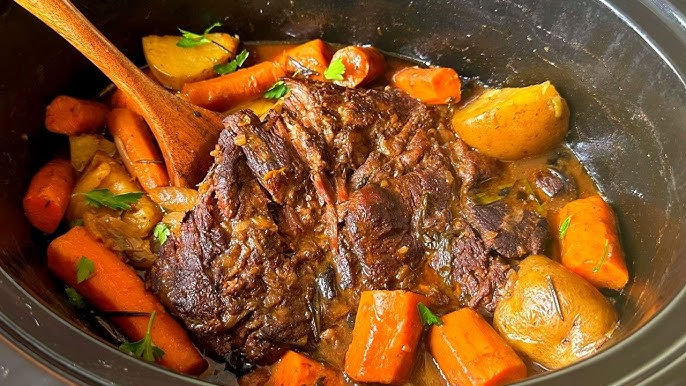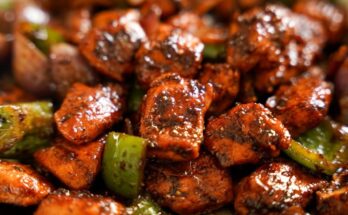Beef Roast Slow Cooker Recipe: There’s something magical about coming home to the aroma of a tender beef roast that’s been simmering in your slow cooker all day. It’s like a warm hug in food form—comforting, hearty, and downright satisfying. Whether you’re prepping for a family dinner, a cozy Sunday meal, or just trying to make the most of a busy weekday, this slow cooker beef roast recipe has your back.
What makes it a fan-favorite? It’s not just the flavor—it’s the convenience. Toss in your ingredients, set the timer, and go about your day. By the time you’re ready to eat, the roast is melt-in-your-mouth tender, packed with savory juices, and surrounded by perfectly cooked vegetables.
In this guide, we’re diving deep into everything you need to know: from the best cut of beef to use, all the way to how to store leftovers (if you have any). Ready to cook like a pro with zero stress? Let’s get into it.
Benefits of Cooking Beef Roast in a Slow Cooker
Slow cookers are the unsung heroes of home kitchens. They may not look flashy, but when it comes to making fall-apart tender beef roast, they win every time. Here’s why:
- Set It and Forget It: You don’t need to babysit your roast. Throw it in, walk away, and come back to perfection.
- Incredible Flavor: Slow cooking gives time for flavors to blend beautifully. The meat absorbs the spices, herbs, and liquid, creating depth you can’t get with faster methods.
- Tender Results: The slow, low heat breaks down the connective tissue in tougher cuts of meat, turning them fork-tender.
- Economical Cooking: You can use cheaper cuts of meat (like chuck roast), and they turn out amazing.
- One-Pot Wonder: Fewer dishes. Fewer headaches. Everything cooks in one pot.
If you’re looking for ease without sacrificing quality, the slow cooker method is a game-changer.
Types of Beef Cuts Best for Slow Cooking
Not all beef is created equal, especially when it comes to slow cooking. For the juiciest, most tender roast, go for cuts that have a bit more fat and connective tissue—they break down and become luscious over time.
Top Cuts for Slow Cooker Beef Roast:
- Chuck Roast – This is the gold standard. It’s marbled with fat and full of flavor. It shreds beautifully.
- Brisket – A tougher cut that becomes wonderfully tender after long cooking. Rich in flavor but needs patience.
- Rump Roast (Bottom Round) – Leaner than chuck but still works well in a slow cooker if not overcooked.
Beef Cut Comparison Table
| Beef Cut | Flavor | Tenderness | Best Use |
|---|---|---|---|
| Chuck Roast | Very High | High | Classic beef roast |
| Brisket | High | Medium | Richer flavor roasts |
| Rump Roast | Medium | Medium | Leaner roast recipes |
Pick the one that fits your taste, but if you’re unsure—start with chuck. It’s the classic for a reason.
Essential Ingredients You’ll Need
Here’s your go-to grocery list for the perfect beef roast:
- 3–4 lbs Chuck Roast (or other preferred cut)
- 4–5 Carrots, peeled and chopped
- 4–5 Potatoes, chopped into chunks
- 1 Large Onion, chopped
- 4 Garlic Cloves, minced
- 2 cups Beef Broth
- 2 tbsp Olive Oil (for searing)
- 1 tsp Salt
- 1 tsp Black Pepper
- 1 tsp Dried Thyme
- 1 tsp Rosemary
- 1 tbsp Worcestershire Sauce
Ingredient Tips:
- Beef Broth: Go low sodium so you can control the salt level.
- Potatoes: Yukon Golds or baby red potatoes work best—they don’t fall apart easily.
- Worcestershire Sauce: Adds a punch of umami and depth to your roast.
Buying fresh, quality ingredients makes all the difference. Aim for grass-fed beef if possible, and don’t skimp on the aromatics like garlic and onion.
Optional Ingredients for Added Flavor
Want to take your slow cooker beef roast to the next level? These optional ingredients can seriously elevate the flavor, texture, and overall vibe of your dish. Think of these as secret weapons in your kitchen arsenal.
Flavor-Boosting Additions:
- Fresh Herbs: Bay leaves, thyme sprigs, or rosemary stems tossed in during cooking can add depth and freshness.
- Red Wine: A splash (½ to 1 cup) of dry red wine enriches the broth and gives your roast a sophisticated edge.
- Balsamic Vinegar: Adds a subtle tang and helps balance the richness of the beef.
- Tomato Paste: For a more savory and slightly sweet profile, stir in a tablespoon.
- Soy Sauce: Just a teaspoon or two adds umami and enhances browning.
Vegetable Variations:
- Celery: Adds a layer of aromatic flavor, especially if you sauté it beforehand.
- Parsnips or Turnips: Earthy and sweet—perfect for a fall or winter twist.
- Mushrooms: They soak up the beefy flavor and add their own umami.
Pro Tip:
Mix and match optional ingredients based on the flavor profile you’re aiming for. Going for classic comfort? Stick to potatoes and carrots. Want something fancier? Add wine, balsamic, and mushrooms.
Kitchen Tools You’ll Need
You don’t need a chef’s kitchen to nail this recipe, but having the right tools definitely helps streamline the process.
Must-Have Tools:
- Slow Cooker (Crock-Pot): A 6–8 quart model is perfect for a 3–4 lb roast plus veggies.
- Large Skillet or Cast-Iron Pan: For searing the meat before slow cooking (totally worth it).
- Tongs: To flip the roast and handle hot food safely.
- Cutting Board & Sharp Knife: For prepping veggies and trimming meat.
- Meat Thermometer: Optional, but great for checking doneness.
- Ladle or Slotted Spoon: For serving up those juicy portions.
Nice-to-Have Extras:
- Fat Separator: Makes skimming fat from the juices a breeze.
- Whisk: Handy if you’re making gravy from the drippings.
Good tools make good food easier. If you’re planning to cook roasts regularly, investing in a decent slow cooker is well worth it.
Step-by-Step Guide to Making Beef Roast in a Slow Cooker
Alright, let’s get cooking. This is where the magic happens, and trust me, it’s easier than it looks. Just follow each step, and you’ll end up with a roast that’s flavorful, juicy, and fall-apart tender.
Step 1: Prepping the Meat
Start by choosing a good-quality cut like chuck roast or brisket. Trim off excess fat but leave some for flavor. Season generously with salt, pepper, garlic powder, onion powder, and herbs like rosemary or thyme. For deeper flavor, marinate the meat for at least 30 minutes—or overnight if you have time.
Step 2: Searing the Beef (Optional but Recommended)
Heat a skillet over medium-high heat and sear the roast on all sides until browned. This step locks in juices and builds a rich, caramelized flavor base.
Step 3: Adding Vegetables and Liquid
Place chopped carrots, potatoes, and onions at the bottom of the slow cooker. Set the seared roast on top and pour in 1–2 cups of beef broth or a mix of broth and red wine. Add a splash of Worcestershire sauce for depth.
Step 4: Setting the Slow Cooker
Cover and set your slow cooker to low for 8–10 hours or high for 4–5 hours, depending on your schedule.
Step 3: Cooking Times for Different Settings
Low heat yields fall-apart tenderness, while high heat gives a firmer texture. Avoid opening the lid during cooking—it releases heat and slows things down.
Step 4: Final Touches and Garnish
Once done, remove the roast and vegetables. Strain the juices and simmer them into a quick gravy. Slice the beef, spoon over the gravy, and garnish with fresh parsley. Serve hot for the ultimate comfort meal!
Cooking Time and Temperature Guide
Cooking times can vary based on the size of your roast and your slow cooker’s heating efficiency. Here’s a quick guide to help you nail it.
| Setting | Time (3–4 lb Roast) | Texture |
|---|---|---|
| Low | 8–10 hours | Fall-apart tender |
| High | 5–6 hours | Firmer, still tender |
Tips to Avoid Overcooking:
- Use a meat thermometer to check internal temperature.
- Start checking after 7 hours on low or 4.5 hours on high.
- Don’t cook smaller roasts for the same time as larger ones.
Tips for Maximum Flavor
Let’s talk about flavor. You want your beef roast to taste like it simmered all day in grandma’s secret kitchen? Here are some tips to get that rich, savory goodness every single time.
1. Sear That Meat First
Yes, we mentioned it earlier—but it’s that important. Browning the beef caramelizes the outer layer, creating what’s called the Maillard reaction. It’s a fancy name for that deep, meaty, almost sweet flavor that only comes from high heat.
- Use a hot pan and don’t crowd the meat.
- Get a dark brown crust on each side—this is where the flavor lives.
2. Use Layers of Aromatics
Think beyond salt and pepper. Here’s how to build layers:
- Garlic and onion give a sweet and savory base.
- Fresh herbs like rosemary and thyme provide brightness.
- Tomato paste or Worcestershire sauce adds a rich umami punch.
- Red wine or balsamic vinegar balances everything with acidity.
Combine all these and your slow cooker will be a flavor powerhouse.
3. Don’t Overdo the Liquid
It’s tempting to flood the pot, but slow cookers don’t need much broth. The meat and veggies release their own juices as they cook.
- Stick to about 2 cups of liquid max.
- Too much liquid will make everything mushy and dilute the taste.
4. Add a Touch of Sweetness
A little sweetness balances the savory flavors.
- Try a teaspoon of brown sugar or a drizzle of honey.
- Sweet root vegetables like carrots or parsnips naturally do this too.
This small tweak makes a big difference in flavor harmony.
Serving Suggestions
Your beef roast is ready, and it smells amazing. But how should you serve it? There’s no one-size-fits-all, but here are some tasty pairings and ideas to make your meal shine.
Classic Sides:
- Mashed Potatoes: Creamy mashed potatoes are the perfect vessel for all that juicy gravy.
- Green Beans or Roasted Brussels Sprouts: Balance the richness with a fresh veggie side.
- Dinner Rolls or Crusty Bread: Soak up all that delicious sauce—don’t let it go to waste!
Creative Serving Ideas:
- Beef Roast Sandwiches: Pile it on a toasted hoagie with melted provolone and a bit of au jus.
- Over Egg Noodles or Rice: Great way to stretch leftovers into another hearty meal.
- Shred it into Tacos or Quesadillas: A fun twist if you’ve got leftovers (or just want to mix it up).
Presentation Tip:
Slice or shred the beef, arrange it neatly over a bed of potatoes and carrots, spoon some gravy over the top, and sprinkle with fresh parsley. It’ll look just as good as it tastes.
How to Thicken the Gravy
Let’s be real—the gravy is everything. Whether you want it rich and velvety or thick and glossy, here’s how to get it just right.
1. Cornstarch Slurry (Fast and Easy)
- Mix 1–2 tablespoons of cornstarch with 2 tablespoons of cold water.
- Stir until smooth, then add to the cooking liquid.
- Simmer on high in the slow cooker (or transfer to a saucepan) until thickened.
2. Reduce the Sauce
- Transfer the cooking liquid to a saucepan.
- Simmer on medium heat for 10–15 minutes until it thickens naturally.
- This method concentrates flavor and doesn’t add starch.
3. Add a Roux
- Melt 2 tablespoons of butter, then whisk in 2 tablespoons of flour to make a roux.
- Slowly whisk in the roast liquid.
- Simmer until thick and glossy.
Whatever method you choose, always taste and adjust seasoning at the end. A little salt, pepper, or splash of vinegar can wake it up.
Storing and Reheating Leftovers
One of the best things about beef roast? The leftovers taste even better the next day. Here’s how to keep them fresh and flavorful.
Storage Tips:
- Refrigerate: Store leftovers in an airtight container within 2 hours of cooking.
- Shelf Life: Lasts 3–4 days in the fridge.
- Keep Gravy Separate: Store the meat and veggies with a bit of gravy, but save the rest separately to avoid sogginess.
Reheating Tips:
- Stovetop: Reheat gently over medium-low heat with some broth or leftover gravy to keep it moist.
- Microwave: Use a microwave-safe container, cover loosely, and reheat in 1-minute intervals. Add a splash of broth before microwaving.
- Oven: Cover with foil and warm at 325°F for about 20–25 minutes.
Avoid overheating—it’ll dry out the meat. Low and slow wins again.
How to Freeze Beef Roast
Freezing beef roast is a smart move—whether you’re meal prepping or just had more leftovers than expected. Done right, it’ll taste just as good weeks later.
Freezing Instructions:
- Cool Completely: Let the roast and veggies cool down before packing.
- Portion It Out: Divide into individual or family-size portions.
- Add Gravy: Spoon some gravy into each container to keep the meat moist.
- Use Freezer-Safe Containers or Bags: Label with the date and contents.
- Freeze Up to 3 Months.
Thawing & Reheating:
- Thaw Overnight in Fridge: Never thaw at room temperature.
- Reheat in Oven or Stovetop: Just like with fresh leftovers, use low heat and moisture to keep it juicy.
Bonus: Frozen roast makes a great quick dinner when you don’t feel like cooking.
Common Mistakes to Avoid
Even with a simple recipe like slow cooker beef roast, a few missteps can turn your tender, juicy dream meal into a dry, flavorless flop. But don’t worry—knowing what not to do is half the battle. Let’s look at the most common pitfalls and how to dodge them like a pro.
1. Skipping the Sear
Yes, we’ve said it before—and for good reason. Searing isn’t just for looks; it adds deep, complex flavor. If you toss raw meat straight into the slow cooker, you’re missing out on that rich, savory crust that makes all the difference.
2. Overcrowding the Slow Cooker
Think you can throw in everything and still get perfect results? Not quite. Overcrowding reduces circulation and causes uneven cooking. Make sure there’s enough room for heat to move around. Stick to the recommended quantities, especially if you’re using a smaller slow cooker.
3. Adding Too Much Liquid
It’s easy to assume more broth = more flavor, but in a slow cooker, moisture doesn’t evaporate like in an oven or stove. Too much liquid will water everything down and make your veggies mushy. Stick to 1.5 to 2 cups of liquid unless the recipe says otherwise.
4. Lifting the Lid
Every time you lift the lid, you release a ton of heat and slow down the cooking process—by up to 30 minutes each time! Unless the recipe calls for it (or you’re checking toward the end), resist the urge to peek.
5. Not Using the Right Cut of Beef
Lean cuts like sirloin might seem like a healthy choice, but they dry out in the slow cooker. You want a cut with good marbling and connective tissue—like chuck roast—that melts into buttery goodness.
6. Forgetting to Let the Meat Rest
Slicing into your roast the second it’s done? Big mistake. Letting it rest for 10–15 minutes helps the juices redistribute, keeping it moist and tender.
By avoiding these common errors, you’re setting yourself up for a foolproof, flavorful meal every time.
FAQs about Beef Roast Slow Cooker Recipe
1. Can I cook the beef roast from frozen in a slow cooker?
Technically, yes—but it’s not recommended for safety reasons. The meat stays in the “danger zone” (40°F to 140°F) too long, which can lead to bacterial growth. Always thaw your roast completely before slow cooking.
2. What can I use instead of beef broth?
If you’re out of beef broth, you can substitute with:
- Chicken broth (lighter flavor)
- Vegetable broth
- A mix of water + bouillon cube
- Red wine or a splash of beer for depth
3. Can I leave the roast cooking overnight?
Absolutely! Slow cooking overnight on low is a great option. Just make sure your slow cooker has an automatic “keep warm” function so it doesn’t overcook after it’s done.
4. How do I make this recipe gluten-free?
Easy—just double-check your beef broth and Worcestershire sauce for hidden gluten (some brands contain wheat). Also, use cornstarch instead of flour to thicken your gravy.
5. What’s the best way to reheat a large portion of leftover roast?
The oven is best for larger portions. Place the roast and veggies in a covered baking dish, add some broth or gravy, and warm at 325°F for 20–30 minutes. This keeps it moist and flavorful.
Conclusion
There you have it—your ultimate, step-by-step guide to making the perfect beef roast in a slow cooker. Whether you’re a seasoned home cook or just getting started, this recipe is a game-changer for busy weeknights, cozy weekends, and everything in between.
The best part? You can customize it to your taste, add your favorite herbs, switch up the veggies, and make it your own. Just remember the golden rules: choose the right cut, don’t rush the process, and layer those flavors.
So next time you want something warm, hearty, and comforting, pull out your slow cooker and give this recipe a go. Your future self (and everyone at the table) will thank you.



